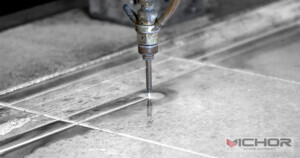
Unleashing Precision: The Role of Ultra High Pressure Water Jet Cutting in Industry
In today’s fast-paced industrial landscape, precision and efficiency are paramount. One technology that stands out for its versatility and effectiveness is ultra high pressure water jet cutting. This innovative method uses a focused stream of water at extremely high pressures to slice through a wide array of materials with incredible accuracy. Unlike traditional cutting techniques that rely on heat or mechanical force, ultra high pressure water jet cutting offers a cold-cutting process that minimizes material distortion and heat-affected zones. This makes it an ideal solution for industries ranging from aerospace to automotive, where precision is non-negotiable. In this article, we will delve into the fundamentals of ultra high pressure water jet cutting, explore its mechanisms, highlight its advantages, discuss its diverse applications, compare it with other methods, and consider safety aspects. By the end, you’ll have a comprehensive understanding of why ultra high pressure water jet cutting is a game-changer in modern manufacturing and fabrication.
What is Ultra High Pressure Water Jet Cutting?
Ultra high pressure water jet cutting is a advanced machining process that utilizes a high-velocity stream of water, often mixed with abrasive particles, to cut through materials. The term “ultra high pressure” refers to water pressures typically ranging from 40,000 to 100,000 pounds per square inch (psi) or even higher. This intense pressure is generated by specialized pumps that force water through a small nozzle, creating a jet that can erode and cut materials with pinpoint accuracy. The process is highly controllable, allowing for intricate designs and complex shapes without compromising the integrity of the material. One of the key aspects of ultra high pressure water jet cutting is its ability to handle a variety of substances, including metals, composites, stone, glass, and plastics. This versatility stems from the fact that it is a non-thermal method, meaning it doesn’t produce heat that could alter material properties. As a result, ultra high pressure water jet cutting is widely adopted in sectors where precision and material preservation are critical. The technology has evolved over the years, with advancements in pump systems and nozzle designs enhancing its efficiency and reducing operational costs. Understanding the basics of ultra high pressure water jet cutting is essential for appreciating its full potential in industrial applications.
How Ultra High Pressure Water Jet Cutting Works
The operation of ultra high pressure water jet cutting involves several key components working in harmony. First, a high-pressure pump intensifies water to ultra-high levels, often using intensifier or direct-drive systems. This pressurized water is then directed through a narrow orifice, typically made of diamond or sapphire, which focuses the stream into a coherent jet. In many cases, abrasive materials like garnet are added to the water stream to enhance cutting power, especially for harder substances. The abrasive particles mix with the water in a mixing chamber before exiting the nozzle, creating a slurry that accelerates material removal. The cutting head is mounted on a computer-controlled gantry or robotic arm, allowing for precise movement along programmed paths. This CNC (Computer Numerical Control) integration enables ultra high pressure water jet cutting to produce highly accurate cuts based on digital designs, making it suitable for prototyping and mass production alike. The process is remarkably efficient, as the water jet can cut at speeds varying from a few inches per minute to over 100 inches per minute, depending on the material thickness and type. Moreover, ultra high pressure water jet cutting generates minimal waste, as the water and abrasives can often be recycled. This operational efficiency, combined with its environmental benefits, underscores why ultra high pressure water jet cutting is favored in many industries. By leveraging this technology, manufacturers achieve clean edges and reduced secondary processing, saving time and resources.
Key Advantages of Ultra High Pressure Water Jet Cutting
One of the most compelling reasons for adopting ultra high pressure water jet cutting is its array of advantages. Firstly, it is a cold-cutting process, meaning it does not generate heat during operation. This prevents thermal distortion, hardening, or micro-cracking in materials, which is common in laser or plasma cutting. As a result, ultra high pressure water jet cutting preserves the material’s original properties, making it ideal for heat-sensitive substances like titanium or composites. Secondly, this method offers exceptional versatility; it can cut virtually any material, from soft foams to hardened steels, without the need for tool changes. This flexibility reduces setup times and increases productivity. Another significant benefit is the precision achievable with ultra high pressure water jet cutting. The technology allows for tight tolerances and intricate details, with kerf widths as small as 0.005 inches, minimizing material waste. Additionally, ultra high pressure water jet cutting is environmentally friendly compared to other methods. It uses water, which is recyclable, and produces no hazardous fumes or dust, contributing to a safer workplace. The process also supports omnidirectional cutting, meaning it can start from any point on the material, reducing piercing issues and expanding design possibilities. Cost-effectiveness is another advantage, as ultra high pressure water jet cutting often requires less post-processing and has lower maintenance costs over time. These benefits collectively make ultra high pressure water jet cutting a superior choice for many applications, driving its adoption across various sectors.
Diverse Applications of Ultra High Pressure Water Jet Cutting
The applications of ultra high pressure water jet cutting span numerous industries, highlighting its adaptability and effectiveness. In the aerospace sector, it is used to cut complex components from composites and alloys, where precision and material integrity are crucial for safety and performance. The automotive industry employs ultra high pressure water jet cutting for fabricating parts like gaskets, interior panels, and even chassis components, benefiting from its ability to handle diverse materials without heat damage. In construction and architecture, this technology is ideal for cutting stone, tile, and glass for decorative elements or structural parts, enabling intricate designs that would be difficult with other methods. The food industry also utilizes ultra high pressure water jet cutting for portioning products like meat and pastries, as it is hygienic and doesn’t introduce contaminants. Moreover, in the medical field, ultra high pressure water jet cutting is used to create precise instruments and implants from biocompatible materials. Even in art and design, artists leverage ultra high pressure water jet cutting to produce detailed sculptures and installations from metals or acrylics. This wide range of applications demonstrates how ultra high pressure water jet cutting meets the demands of modern manufacturing, offering solutions that enhance creativity, efficiency, and quality. As industries continue to evolve, the role of ultra high pressure water jet cutting is likely to expand, driven by its unmatched versatility.
Comparing Ultra High Pressure Water Jet Cutting with Other Cutting Techniques
When evaluating cutting technologies, it’s important to compare ultra high pressure water jet cutting with alternatives like laser cutting, plasma cutting, and mechanical milling. Laser cutting uses focused light beams to melt materials, making it fast for thin metals but prone to heat effects, which can compromise material properties. In contrast, ultra high pressure water jet cutting avoids thermal damage, making it better for heat-sensitive materials. Plasma cutting, which relies on ionized gas, is efficient for thick metals but produces a wider kerf and heat-affected zones, limiting precision. Ultra high pressure water jet cutting, however, offers finer cuts and no heat distortion, though it may be slower for very thick sections. Mechanical milling involves physical tools that wear out over time, leading to increased costs and downtime. Ultra high pressure water jet cutting has no tool wear in the traditional sense, as the abrasive nozzles are durable and replaceable. Additionally, ultra high pressure water jet cutting excels in cutting reflective or transparent materials that challenge laser systems. While each method has its niche, ultra high pressure water jet cutting stands out for its versatility, precision, and environmental benefits. This comparison shows why many industries are integrating ultra high pressure water jet cutting into their processes, especially for applications requiring high accuracy and material diversity.
however, offers finer cuts and no heat distortion, though it may be slower for very thick sections. Mechanical milling involves physical tools that wear out over time, leading to increased costs and downtime. Ultra high pressure water jet cutting has no tool wear in the traditional sense, as the abrasive nozzles are durable and replaceable. Additionally, ultra high pressure water jet cutting excels in cutting reflective or transparent materials that challenge laser systems. While each method has its niche, ultra high pressure water jet cutting stands out for its versatility, precision, and environmental benefits. This comparison shows why many industries are integrating ultra high pressure water jet cutting into their processes, especially for applications requiring high accuracy and material diversity.
Safety and Environmental Considerations in Ultra High Pressure Water Jet Cutting
Safety is a critical aspect of any industrial process, and ultra high pressure water jet cutting is no exception. The high pressures involved require robust safety measures, such as enclosed cutting areas and pressure relief systems, to prevent accidents. Operators must wear protective gear, including goggles and gloves, to shield against high-velocity debris and water mist. Noise levels can be significant, so hearing protection is often necessary. From an environmental standpoint, ultra high pressure water jet cutting is relatively green. It uses water, which can be filtered and reused, reducing consumption. The abrasives, like garnet, are natural and non-toxic, though proper disposal is needed to avoid sedimentation issues. Unlike thermal methods, ultra high pressure water jet cutting produces no harmful emissions or ozone-depleting substances, aligning with sustainability goals. Regular maintenance of pumps and nozzles ensures efficiency and minimizes waste. By adhering to safety protocols and environmental best practices, businesses can leverage ultra high pressure water jet cutting responsibly, enhancing their operational safety and eco-friendliness.
The Future of Ultra High Pressure Water Jet Cutting
The future of ultra high pressure water jet cutting looks promising, with ongoing innovations aimed at improving speed, precision, and accessibility. Advances in pump technology may lead to higher pressures and more efficient energy use, reducing costs. Integration with AI and IoT could enable predictive maintenance and real-time monitoring, optimizing performance. As materials science evolves, ultra high pressure water jet cutting might adapt to new composites and alloys, expanding its applications. Additionally, efforts to make systems more compact and user-friendly could bring this technology to smaller workshops and creative industries. The emphasis on sustainability may drive developments in water recycling and eco-friendly abrasives. Overall, ultra high pressure water jet cutting is poised to remain a vital tool in manufacturing, continually adapting to meet industry demands.
Frequently Asked Questions
Q1: What materials can be cut using ultra high pressure water jet cutting?
A1: Ultra high pressure water jet cutting can handle a wide range of materials, including metals (like steel, aluminum, and titanium), composites, stone, glass, ceramics, plastics, rubber, and even food products. Its versatility makes it suitable for various industries.
Q2: How thick of a material can ultra high pressure water jet cutting handle?
A2: This technology can cut materials up to several inches thick, depending on the type. For instance, it can slice through metals up to 6-8 inches thick and softer materials even thicker, though cutting speed may decrease with thickness.
Q3: Is ultra high pressure water jet cutting environmentally friendly?
A3: Yes, ultra high pressure water jet cutting is considered environmentally friendly because it uses water, which is often recyclable, and natural abrasives. It produces no toxic fumes or hazardous waste, reducing its environmental impact compared to thermal cutting methods.
Q4: What are the main limitations of ultra high pressure water jet cutting?
A4: The primary limitations include slower cutting speeds for very thick or hard materials, higher initial equipment costs, and the need for regular maintenance of high-pressure components. Additionally, it may not be as efficient for simple, high-volume cuts as some other methods.
Q5: How does ultra high pressure water jet cutting compare in terms of cost?
A5: While the initial investment in ultra high pressure water jet cutting equipment can be high, it often proves cost-effective over time due to reduced material waste, lower post-processing needs, and versatility across multiple materials. Operational costs include water, abrasives, and maintenance, but these are generally manageable with proper planning.
continue reading
Related Posts
- 1469 words7.4 min read
- 1821 words9.2 min read



